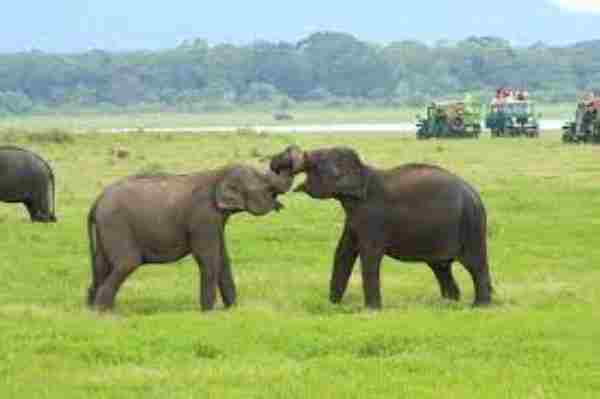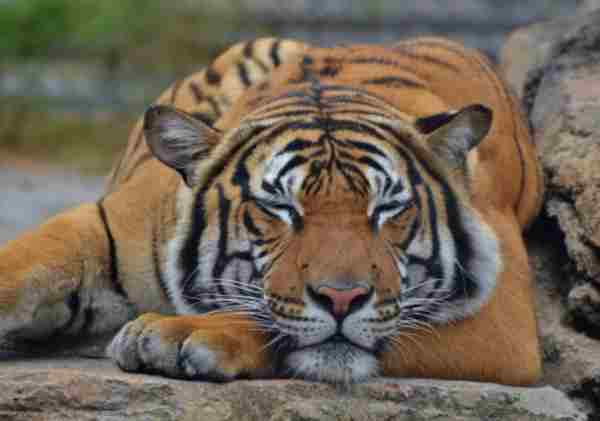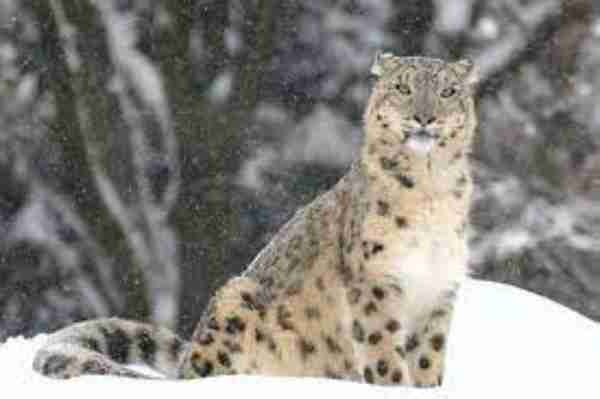Welcome to the world of fascinating wildlife of Nepal, a country that is renowned worldwide for its magnificent Himalayan Mountain range. While it is true that the highest peak in the world, Mount Everest, lies in this beautiful country, it is equally true that Nepal is also home to a diverse range of breathtaking wildlife.
Table of Contents
From the majestic Bengal Tiger to the elusive Snow Leopard, the wildlife in Nepal is abundant and captivating. In this blog, we will dive into the heart of Nepal’s wilderness, exploring the habitat, behaviours, and unique features of some of its most fascinating creatures.
Whether you are an avid wildlife enthusiast or simply looking to learn more about the natural world around you, Wildlife in Nepal has something for everyone. So come, let’s take a journey together and discover the breathtaking beauty of Nepal’s wildlife.
Asiatic elephant

In Nepal today, the Asian elephant stands as the largest mammal. It can reach a shoulder height ranging from 2.5 to 3 meters, with male elephants weighing up to 5,000 kg!
These majestic creatures possess remarkable memory and enjoy a lifespan similar to that of humans. They are highly sociable and live in groups consisting of related animals, led by a mature female. Within the same group, communication takes place through sound, scent, and touch.
Elephants can emit sonic sounds, which are low-pitched and fall beyond the range of human hearing. This ability proves particularly valuable for long-distance communication since lower-pitched sounds can travel greater distances.
The elephant’s trunk, an elongated nose with nostrils at its tip, serves as a delicate and versatile tool. It enables them to perform a variety of tasks, from moving heavy tree trunks to picking up objects as small as a peanut. The Asian elephant possesses a single “finger” on the upper lip of its trunk.
Within Nepalese culture, elephants hold great significance, and the country has a longstanding history of domesticating wild elephants for various purposes. Hindu religious texts abound with stories featuring elephants.
The use of domesticated Asian elephants in Nepal can be traced back to the time of King Man Dev of the Lichhavi Dynasty. According to historian Baburam Acharya, the kings of Makwanpur captured wild elephants from the Bhabar forests and sold them to the Mughal rulers of India.
Jung Bahadur Rana, the first Prime Minister of the Rana dynasty, is reputed to have captured three wild elephants in 1851 AD using the challenging technique known as “kheda.” During the Rana regime, domesticated elephants were considered indispensable for burdensome tasks, and the Rana rulers established Hattisars (camps for domesticated elephants and their handlers) for big game hunting. Nepal had a total of 32 permanent and temporary Hattisars during that era.
Elephants are often described as versatile vehicles capable of traversing various terrains. They symbolize strength and status. In earlier times, trained elephants served as a means of transportation and were used for big game hunting. Rulers of Asian nations recognized the versatility of trained elephants and employed them in warfare, timber trade, transportation of goods, and religious ceremonies.
The one-horned rhinoceros

The Indian rhinoceros, also known as the greater one-horned rhinoceros, is a massive grey creature, second in size only to elephants. An adult rhino typically weighs between 2 and 2.5 metric tonnes. While rhinos generally lead solitary lives, they may also gather to graze and wallow together. Calves stick with their mothers for 1 to 3 years. Female rhinos reach sexual maturity between 5 and 7 years of age, while males become mature at around 10 years old.
The greater one-horned rhinoceros is primarily found in South Asia and Southeast Asia. Historically, these rhinos inhabited the floodplains and forest areas along the Brahmaputra, Ganges, and Indus river valleys. However, today there are no more than 2,000 of them left in the wild, with only two populations exceeding 100 individuals:
Kaziranga National Park in Assam, India (1,200) and Chitwan National Park (CNP) in Nepal (600). Despite joint efforts between Bhutan and India, the survival of a small rhino population along the Indo-Bhutan border in Manas remains uncertain.
In Nepal, the rhino population in the Chitwan Valley was estimated to be around 1,000 until 1950. The area received protection from the Rana rulers for the purpose of sport hunting and was isolated from outsiders due to the prevalence of malaria. Only a few indigenous communities, like the Tharus, who were immune to the disease, inhabited the region. Their impact on the natural environment was minimal.
However, after the collapse of the Rana regime in 1950 and the subsequent eradication of malaria in the mid-1950s, Chitwan opened up to outsiders. Thousands of people migrated from the mid-hills, leading to the large-scale clearance of wildlife habitats for human settlements, agriculture, and other development activities.
This deforestation and the ensuing poaching significantly impacted the forest and wildlife, particularly large mammals such as rhinos. Consequently, the rhino population plummeted to less than 100 individuals in the late 1960s.
Recognizing the urgent need to halt the decline of the rapidly diminishing rhino population, the Government of Nepal established the “Gainda Gasti,” an armed Rhino Patrol Unit, in 1961. In 1973, the remaining prime rhino habitats, covering approximately 544 sq km along the Rapti, Narayani, and Reu rivers, were declared as the Chitwan National Park (CNP).
The park’s boundaries were later expanded to a total area of 932 sq km, and it was designated as a World Heritage Site in 1984 for its rich biological diversity.
Thanks to the successful efforts of the Department of National Parks and Wildlife Conservation (DNPWC), the declining rhino population began to gradually recover. CNP serves as an example of a population on the brink of extinction that has rebounded strongly while maintaining a high level of genetic diversity.
Rhinos thrive in the alluvial floodplain vegetation of subtropical climates, where water and lush green grass are available year-round. Many rhinos now inhabit blocks of suitable rhino habitat within CNP. The highest rhino densities are found along the floodplain grasslands and riverine forests adjacent to the Rapti, Narayani, Reu, and Dhungre rivers, suggesting that floodplain grasslands dominated by 4-6 m tall Saccharum spontaneous are the most crucial habitats for these magnificent creatures.
Royal Bengal tiger

Tigers are the most captivating and widely recognized among all the large cats in Asia. They bear slender black, brown, or grey stripes on their heads, bodies, and limbs. Each tiger can be easily distinguished by its unique pattern of stripes.
An adult tiger can measure up to nearly 3 meters from nose to tail tip and can weigh over 250 kg. Adult tigers are primarily solitary animals, primarily preying on deer and wild pigs. However, at times, two tigers with adjacent territories may interact with each other in a friendly manner. Depending on the availability of prey, their territories can range from 10 to 400 km2 for females and 30 to 1,000 km2 for males.
Tiger cubs stay with their mother until they reach the age of two. While the instinct to catch moving prey is innate in tigers, they require a long learning process to acquire the skills needed to capture wary and fast prey animals. Tigers are not replaced in their range until they die.
Tiger populations face threats such as depletion of prey, poaching, habitat degradation, and fragmentation. These threats arise from various factors related to local rural activities and economic development projects. The crucial challenge now lies in prioritizing the appropriate response to these threats. In Nepal, habitat fragmentation, loss of natural habitat, and poaching pose significant obstacles to effective conservation.
Tigers are at serious risk of extinction in the wild. There were once nine tiger subspecies: Bengal, Siberian, Indochinese, South Chinese, Sumatran, Malayan, Caspian, Javan, and Bali. Out of these nine subspecies, the last three are already extinct, and the rest are endangered. Historically, the tiger range extended from Turkey, the Tibetan plateau, Manchuria, to the Sea of Okhotsk in South and Southeast Asia.
Since 1998, tigers have lost 40 per cent of their habitat, and currently, they occupy only about seven percent of their former range. They are now confined to South and Southeast Asia, China, and the Russian Far East. They can be found in countries such as Bangladesh, Bhutan, China, Cambodia, India, Indonesia, Laos, Malaysia, Myanmar, Nepal, Russia, Thailand, and Vietnam.
Tigers were once distributed across the lowland Terai and adjacent foothills of Nepal. However, after the collapse of the Rana regime in the 1950s and the eradication of malaria in the mid-1950s, Chitwan became accessible to outsiders. This led to the clearing of large areas of wildlife habitat for human settlements, agriculture, and other development activities.
Uncontrolled hunting of wild animals further decimated the mammalian species, including tigers and rhinos, in the region. By the early 1970s, the swamp deer, one of the major prey species for tigers, disappeared from Chitwan. A significant decrease in the tiger population was observed during the 1960s and 1970s.
In 1964, the late King Mahendra declared the southern part of the Chitwan Valley as Mahendra Mriga Kunj. Subsequently, in 1973, the National Parks and Wildlife Conservation Act 2029 was enacted, and Chitwan National Park was established. Alongside the park’s establishment, the Tiger Ecology Project commenced in the early 1970s as a collaboration between the government of Nepal, the Smithsonian Institution, and the World Wildlife Fund to conduct research on tigers and their prey species.
Based on the recommendations of these studies, the park boundaries were expanded in 1977 to the current size of 932 sq km. Additionally, the Parsa Wildlife Reserve was gazetted in 1976 as an extension of Chitwan National Park
Snow Leopard

Snow leopards inhabit only the mountains of Central Asia and the Himalayas. The estimated global population of snow leopards ranges from 4,510 to 7,350 individuals, with a potential habitat covering approximately 1,835,000 km2 across 12 countries within the snow leopard range. Additionally, around 600 to 700 snow leopards are kept in zoos worldwide.
In Nepal, snow leopards are primarily found along the northern border. Districts such as Mustang, Mugu, Dolpo, and Humla are notable for their snow leopard populations. A habitat suitability index model suggests that Nepal’s northern border is home to an estimated 350 to 500 snow leopards, accounting for about one-tenth of the global population.
Snow leopards have been reported in eight mountain-protected areas in Nepal based on sightings, reports, and oral history. These areas include the Annapurna Conservation Area, Shey Phuksundo National Park, Kangchenjunga Conservation Area, Manaslu Conservation Area, Makalu Barun National Park, Dhorpatan Hunting Reserve, Sagarmatha National Park, and Langtang National Park.
Snow leopards have smoky-grey fur, weigh around 35 to 55 kg (females: 35-40 kg, males: 45-55 kg), measure approximately 1.8 to 2.3 meters in length from head to tail, and stand at 60 cm shoulder height. They have short forelimbs and long hind limbs, which provide agility in steep and rugged terrain. Their fur is yellowish with distinct dark greyish-black rosettes and spots.
The long tail helps them balance on cliffs and provides warmth in cold conditions. Snow leopards have large paws that aid in walking on snow. Mating occurs between January and March, and cubs are born in late spring or early summer. Cubs typically spend their first few weeks in rock crevices before becoming independent at 18 to 22 months of age.
Snow leopards in Nepal face threats to their long-term survival, including conflicts with humans due to livestock depredation and retaliatory killings, poaching, and habitat loss caused by livestock density in grazing areas. The snow leopard-human conflict arises from the leopards preying on sheep, goats, horses, and yak calves. Habitat degradation continues due to year-round grazing pressure resulting from the closure of the Tibetan border several decades ago.
As opportunistic predators, snow leopards often kill livestock due to frequent encounters and inadequate guarding by herders. Poaching is primarily driven by the demand for snow leopard pelts, bones, and body parts in oriental medicine. Illegal trade between Nepal’s northern border and the Tibet Autonomous Region of China has made poaching a lucrative activity.
Efforts for snow leopard conservation have been initiated in protected areas such as the Annapurna Conservation Area, Shey Phuksundo National Park, and Kangchenjunga Conservation Area. Grass-root measures have been implemented, including the establishment of local snow leopard conservation committees (SLCCs) and workshops on survey methods and field techniques.
The involvement of national and international organizations, including the Department of National Parks and Wildlife Conservation, Department of Forest, National Trust for Nature Conservation, WWF Nepal, International Snow Leopard Trust, UNDP/GEF, and USAID, further supports snow leopard conservation efforts.
FAQs
What wildlife lives in Nepal?
Nepal, nestled in the Himalayas, is home to a diverse array of wildlife. Inhabiting tropical forests, alpine regions, and grasslands, the country boasts over 800 species of birds and 200 species of mammals. Nepal is home to the One-horned Rhinoceros and the Bengal Tiger, both of which are listed as endangered by the International Union for Conservation of Nature (IUCN). Other iconic species include the Himalayan black bear, snow leopard, red panda, and Asiatic elephant.
What is the most dangerous animal in Nepal?
The Bengal Tiger
Are there lions in Nepal?
Despite being a rare sight, the Asiatic lion can be found in the western regions of Nepal, particularly in Bardia National Park and Shuklaphanta Wildlife Reserve.
Which is the famous wildlife park in Nepal?
Among the country’s many national parks and wildlife sanctuaries, Chitwan National Park stands out as one of the most famous. Located in southern Nepal, Chitwan is a sprawling park that covers over 950 square kilometers of stunning landscapes, including lush forests, grasslands, and rivers.
Final Words
Wildlife in Nepal is truly mesmerizing. From the majestic tigers to the graceful rhinos and the elusive snow leopards, Nepal is home to some of the most incredible animals in the world. But unfortunately, their populations are declining at an alarming rate, and little is being done to help save these gorgeous creatures.
Nepal’s wildlife needs our immediate attention and support. Conservation efforts must be improved to ensure the survival of these animals for generations to come. We must act as responsible citizens of the world and take action to preserve the natural beauty of Nepal before it’s too late.
Reference:
- https://www.wwfnepal.org/our_work_/wildlife/
- https://www.tripadvisor.com/Guide-g293889-k4777-Nepal.html
- https://news.mongabay.com/2022/12/for-nepal-2022-was-a-roaring-year-of-the-tiger/
A motivated philosophy graduate and student of wildlife conservation with a deep interest in human-wildlife relationships, including wildlife communication, environmental education, and conservation anthropology. Offers strong interpersonal, research, writing, and creativity skills.










